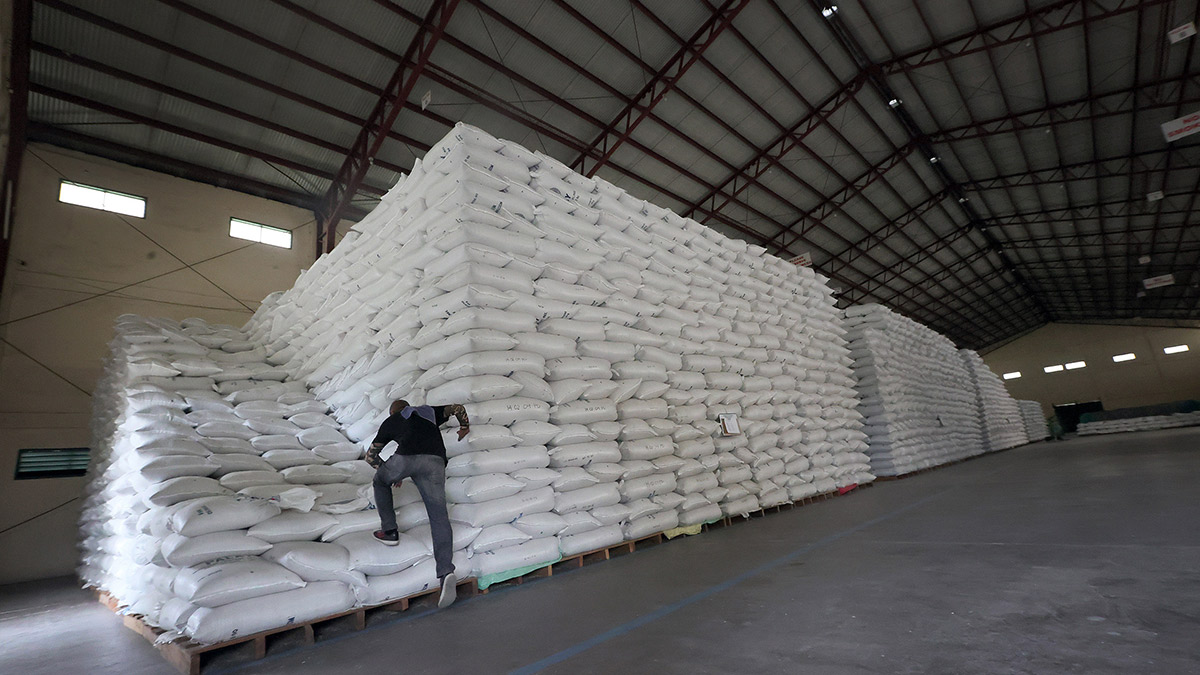
PALAY STOCK Bags of palay (unhusked rice) that the government bought recently from local farmers are kept in a National Food Authority warehouse in Balagtas, Bulacan. —Grig C. Montegrande
MANILA, Philippines — The National Economic and Development Authority (Neda) board, chaired by President Ferdinand Marcos Jr., has agreed to cut the tariff on rice to 15 percent from 35 percent to help bring down the price of the staple food to P29 a kilo for poor and vulnerable Filipinos.
In a press briefing in Malacañang on Tuesday, Neda Secretary Arsenio Balisacan announced the approval of the new Comprehensive Tariff Program (CTP) from 2024 to 2028, which also included reductions in tariffs on other essential items in the energy and manufacturing sectors and kept the prevailing low rates on key agricultural products.
READ: Tariff cut on imported rice: A gamble local farmers won’t take
Although rice prices would not drop drastically due to increasing world prices, Balisacan said the new tariff rates on rice and other products would “benefit everyone.”
“With the tariff reduction from 35 percent, everyone will benefit from that, and this is crucial because world prices are still increasing. If we don’t reduce the tariff, with the increasing world prices compounded by the 35-percent tariff over and above that, prices and inflation will remain to be a very serious problem. With this, we expect those upward pressures and rice prices to ease,” Balisacan noted.
READ: More cuts to rice tariffs urged to tame inflation
Inflation rose to 3.8 percent in April, of which nearly half (1.75 percentage points) was due to rice, data from the Philippine Statistics Authority showed.
Importers to benefit
Balisacan said Neda was optimistic that the lower tariff on the staple grain would bring rice prices down to as low as P29 a kilo, making it affordable to the poor.
“The P29 is our target cost of rice for the poor, those who are targeted for the 4Ps. It’s not a general price. Our concern is, the government should help those who are least able to cope with the rice price,” Balisacan pointed out, referring to Filipinos who are beneficiaries of the Pantawid Pamilyang Pilipino Program.
Additional financial support for the poor to improve their access to affordable rice at Kadiwa centers will be channeled through the 4Ps program of the Department of Social Welfare and Development, which will also ramp up the implementation of its food stamp program.
He said the lower prices of rice were expected to be felt within the year as soon as the President issued an executive order to implement the new tariff scheme.
Jayson Cainglet, executive director of the agricultural advocacy group Samahang Industriya ng Agrikultura, expressed disappointment in the tariff rate cuts, noting that lowering rice tariffs had not resulted in more affordable rice prices and had benefited only a few privileged rice importers and traders for the past years.
“Reduced rice tariffs paved the way for more rice imports, and yet rice prices have only gone up,” Cainglet said in a Viber message.
Manufacturing inputs
The latest CTP, which is reviewed every five years, also maintained the current rates ranging from zero to 65 percent on several agricultural and industrial products.
Balisacan said the Neda board agreed to maintain the current rates on raw materials and intermediate inputs used in manufacturing that have low applied tariffs and merged tariff lines on certain chemicals, textiles, machinery, and transport equipment to “simplify the tariff structure for more efficient customs administration and improve the ease of doing business.”
The Neda board also agreed to reduce tariff rates on certain chemicals used in manufacturing antiseptics, detergents and coal briquettes to improve energy security and lower production costs.
Balisacan said lower tariffs on coal “will help ensure its availability at reasonable prices, thus supporting more stable electricity prices and supply in the country.”
The reduced tariff rates on corn, pork and mechanically deboned meat were also maintained “to ensure [a] stable supply of these commodities, help manage inflation, promote policy stability and investment planning, and enhance food security.” —with a report from Mariedel Irish U. Catilogo